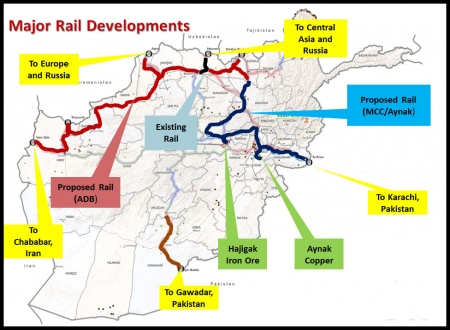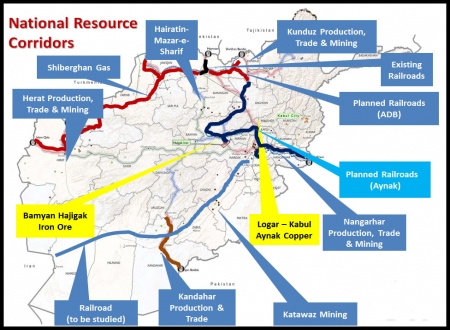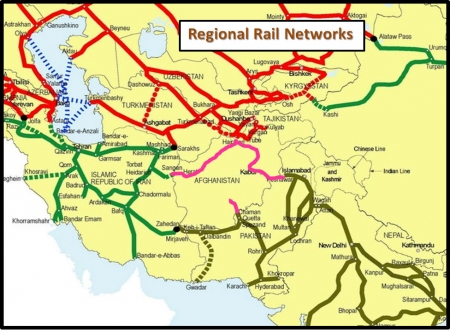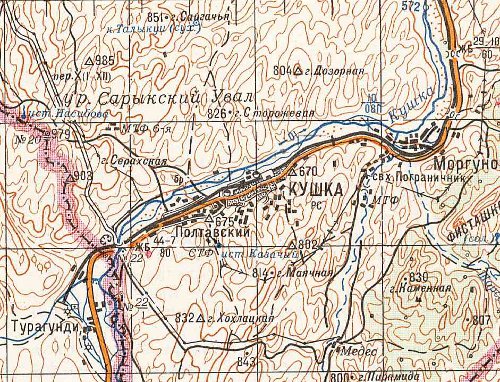Zeitschrift der OSShD is a magazine published six times a year in German, Russian and Chinese versions by OSJD, the Organisation for Co-Operation between Railways. The 2/2011 (316) issue has an article (pp1-6) “Tadjik steel railway lines – conquering the mountain peaks” by Amonullo Hukumatullo, head of Tajikistan’s national railway Rohi Ohani Tojikiston. It gives an overview of the railway company, and includes some information about proposed rail links to Afghanistan.
A map accompanying the OSJD article shows a proposed railway from Kashgar (Kashi) in China to Afghanistan. From Kashgar the line runs though Sary-Taşh in Kyrgyzstan (from where a branch would run north to Osh), crossing the Kyrgyzstan/Tajikistan border near Карамык (Karamyk), meeting the existing line from Душанбе (Dushanbe) at Иляк (Ilyak?) a short distance southeast of Ваҳдат (Vakhdat), then running to Яван (Yavan?), and onwards over a line which is currently under construction to reach Курган-Тюбе (Kurgan-Tyube, and countless other romanisations).
Leaving the existing Uzbekistan to Kurgan-Tyube line at Джалоліддіна Румі (Jaloliddina Rumi) a new 59 km line costing USD73.2m will run to the Tajik border post at Нижний Пяндж (Nizhniy Panj, which is the Russian name; it’s Панҷи Поён (Panji Poyon) in Tajik).
(There was once a 750 mm gauge line on this section of the route, built in 1929-31 and opened in early 1932 but closed in the 1990s. In 2007 a road bridge was opened over the river Amu or Panj Darya which forms the Tajik-Afghan border, called – inevitably – the “Bridge to Friendship”.)
The map shows the railway entering Afghanistan at Shirkhan Bandar, and continuing to Kunduz. From Kunduz proposed lines are shown running south to Kabul and the Khyber Pass, with a spur to Aynak for the mine, and also west along the northern corridor to Mazar-i-Sharif, Herat and Iran.
There are the usual comments in the article about transit traffic, and how a line though Afghanistan would would mean [insert name]-stan would not have not send traffic though [next door]-stan in order to reach Iran. Tajikistan currently has three sections of railway, but they run east-west and are not interconnected with each other except through Uzbekistan, and there have been claims that Uzbekistan has been delaying Tajikistan-bound traffic.
The magazine article also discusses the gauge problem, coming down in favour of 1435 mm standard gauge for the China – Iran route, rather than the 1520 mm of the existing lines Tajikistan.
Here is a rough attempt at plotting the places in question on a map.
View China – Tajikistan – Afghanistan railway in a larger map
This posting is based on the German version of the OSJD magazine, because I can read a little German. However the place names in the magazine have gone from Cyrillic (and probably Russian rather than Tajik) to German romanisation, though the map itself is in Cyrillic. While I have tried to sanitise the names, they have possibly got mangled en route. No offence is intended if your favourite spelling has been missed! It doesn’t help that some places have changed their names over the years – while it’s perhaps no surprise that Stalinabad has disappeared from the map (it is now Dushanbe), it is less obvious that Kolkhozobod became Jaloliddina Rumi in 2007, in honour of a C13th poet.
Tajikistan is a bit of an information black hole – I can’t even find many photos of trains there, or an official railway website.
Back in January 2011, Hukumatullo told a news conference that more than 160 000 tons of freight were shipped to Afghanistan via Tajikistan in 2010: Since there is now direct rail link connecting Tajikistan and Afghanistan, the cargo was transported from the Tajik railroad station Kolkhozobod to the Afghan settlement of Sherkhan Bandar by vehicles.
I suspect now should read no, and vehicles means road vehicles.



